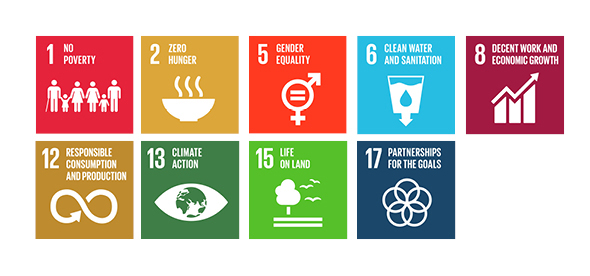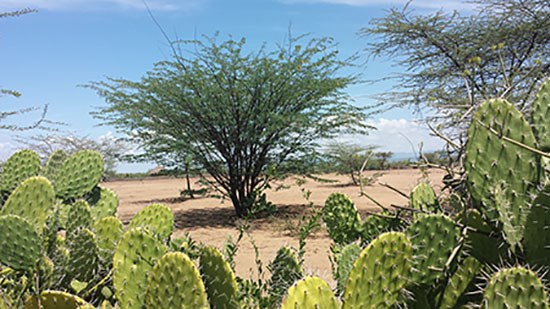The activities within the theme relates to several of the Sustainable Development Goals within the Agenda 2030:

- Goal 1 and 2 through a focus on food production as means to restore degraded landscapes. Higher crop and livestock yield and more nutritious food ensures not only food situation to poor people, but also the economic outcomes of the agricultural activities
- Goal 5 through agricultural diversification enabling more and new niches for women entrepreneurship
- Goal 6 through the importance of restoration in flows of water in the landscape and in soils (e.g. reduced runoff and increased ground water recharge)
- Goal 8 as increased agricultural production and intensification means growth and diversification of local economies
- Goal 12 responsible production also means sustainable and resilient production; vital in restoration research and activities
- Goal 13 both in sequestering carbon (mitigation) and in building adaptation capacity
- Goal 15 this is the core for the theme: “Protect, restore and promote sustainable use of terrestrial ecosystems, sustainably manage forests, combat desertification, and halt and reverse land degradation and biodiversity loss”
About the theme
Many dryland areas have a history of overgrazing and degraded lands with low productivity, recurrent famines, resource conflicts, and economic and political marginalization of pastoralist communities. In dry areas, livestock keeping (pastoralism) is the only source of livelihood and especially pastoralists in Sub-Saharan Africa have challenges with low livestock productivity.
When land is degraded its productivity declines and if severe, people might be forced to migrate to other areas to be able to support the family. As land has not been a limiting factor so far it has led to failure in sustainable land-use for many decades. Large areas of land in tropical regions have been overused and left with the natural restoration capacity degraded and with little effort to sustain biological production, biodiversity and other ecosystem services
Drylands cover around 40% of the world and more than 2 billion people depend on arid and semi-arid lands. Drylands also host around 50% of the livestock kept in the world and are to a large extent held in pastoralist systems. A large part of the worlds´ pasturelands (i.e., dry savannahs) is degraded by poor management, causing severe erosion. When trees disappear from the savannah the soils get a very hard crust that is impenetrable to rainfall resulting in gullies and no vegetation cover at all. Preventing land degradation and supporting a sustainable development in the drylands has a major impact for food security and livelihoods. A challenge is however to improve rangelands and the pasture persistence and productivity under the many constrains the arid and semi-arid landscapes are facing. In addition, the ongoing change in the climate, affects the drylands and already now the effects can be seen with more frequent droughts and more unpredictable rainy seasons.
TripleL – a research network within this theme
To fully understand causes behind land degradation and also to find solutions to arrest and restore already degraded landscapes a multidisciplinary approach is necessary. In this theme we developed a research network, TripleL, with focus on the transition from nomadic pastoralism to a livestock based agro-pastoralism in semi-arid drylands. Triple L consists of national and international researchers, local authorities, development workers (e.g. Vi-agroforestry), farmer representatives and extension staff (field advisors) and the platform has so far organized stakeholder workshops, field visits, capacity development, and initiated students’ research projects.
Ground water recharge and livestock feed in drylands of Tanzania
Lufunyou Lulandala and Peter Ruvuga are admitted as PhD students at SLU in a sandwich mode and are both within the Food Security sub-programme of the capacity development programme between University of Dar es Salaam and Swedish universities (e.g. SLU) financed by Sida. Read more.
Study of a restoration project on Borneo reveals: a refuge for endangered elephants
Degraded rainforests in Borneo has some areas that has been successfully rehabilitated for example the INIKEA restoration project, lead by SLU*, IKEA and Sabah Foundation. In a pilot project SLU researcher Navinder Singh and his MSc student Laia Crespo Mingueza are getting information about elephants and the other biodiversity of the INIKEA area which has never been systematically recorded before. Read more.
*The Elephant project was funded by our theme, Restoration of degraded rural landscapes, while the main restoration project is funded by IKEA and the Kamprad Family Foundation.
Landscape restoration on a global scale - seminars
The theme Restoration of degraded rural landscapes invited Dr. Lars Laestadius, an alumnus to SLU, to give seminars on landscape restoration on a global scale at SLU in Umeå and in Uppsala on 27/9 and 2/10 2017. Read the seminar report here.
Theme leaders
Theme leader: Ewa Wredle ewa.wredle@slu.se
Deputy theme leader: Gert Nyberg gert.nyberg@slu.se

